Look Back 2024 Part Six: Affordable Housing and Charlottesville’s new development code
Thankfully the final look back at the previous calendar so we can get on with the next one!
This is the sixth final edition of my look back at 2024. While I am certain there are some of you who appreciated this work, I suspect there are others who would like to look forward. For me, I find it invaluable to have spent about 40 hours going through Information Charlottesville.
A reason to have done this is to find out what loose threads I may have left and to remind myself of what questions I need to ask. We live in a community experiencing a lot of change, and that’s been the case since I moved here in 2002. I’ve documented a lot of it and with your support I’ll document more.
Before we get into this review, some ways you can help contribute.
Sign up for a paid subscription through Substack. There is not much premium content because my primary aim is to get information out to as many people as possible.
Contribute through Patreon. A major goal this year is to replace this with a way to make a tax-deductible donation, but that’s not set up yet. If I had more time, I’d make more audio programs through Patreon.
Send in a check made out to Town Crier Productions at PO Box 1754, Charlottesville, Virginia, 22902
Ask me about advertising opportunities! Later this month, advertising will begin to appear on Information Charlottesville and I’m hoping it can have the same style as the shout-outs.
Tell friends about the work!
And with that the holiday-related self-promotion ends.
The Year in Affordable Housing
Why is there an affordable housing problem? I can’t fully answer that, but I can write a lot about what decisions were made in 2024 to try to increase the amount of places people can live that are affordable. There are many possible solutions that have been tried out over the years.
One of those solutions is to use the city’s zoning rules to “promote the creation and preservation of affordable housing” and “encourage the construction and continued existence of moderately priced housing by providing for optional increases in density in order to reduce land costs.”
Those are direct quotes from the Development Code that went into effect on February 19. Two weeks before, Council adopted an Affordable Dwelling Unit manual. However, if you go to the city’s main zoning page, there’s no direct link to this document. You’d have to look at the Affordable Dwelling Unit Program page. Here’s a link to those who may not have read it.
“The ADU Program requires residential developments of 10 or more units to set aside new affordable dwelling units at designated Area Median Income (AMI) levels, providing incentives through a density bonus,” reads the website. “This manual governs the administration of the ADU Program and will be annually evaluated and updated by the Office of Community Solutions.”
Council adopted the manual on February 5 after a presentation in which they also learned about how anti-displacement efforts would be factored into the work of the Office of Community Solutions.
“The emphasis with that is to concentrate several measures to be effective in areas of our communities, zones that have been identified as sensitive, or have unique vulnerabilities,” said Antoine Williams, the city’s housing program manager.
More on the Development Code at this installment. The new rules are the third product of the Cville Plans Together initiative. The first was the Affordable Housing Plan adopted in March 2021 that morally committed the elected body to spend at least $10 million on the construction, preservation, and maintenance of places that can be rented or sold to people below certain income thresholds. More details on that are coming up in the next issue of C-Ville Weekly in which I wrote the cover story.
In April, Council approved funding for twelve projects from the dedicated Charlottesville Affordable Housing Fund as well as the Housing Operations and Program Support. One from the CAHF was $250,000 for Piedmont Housing Alliance’s partnership project with Woodard Properties at 501 Cherry Avenue.
More funding for Southwood and another mobile home park
In January, the Albemarle Board of Supervisors also committed $1.5 million to Habitat for Humanity of Greater Charlottesville to subsidize rents for 14 units at the Cardinal Hill Apartments at Southwood. In June, Supervisors considered $1.49 million to help Habitat pay for some of the costs associated with improving the sewer and septic system in the second phase of the Southwood redevelopment.
“The proposed project would remove and replace the remaining fifty septic systems at Southwood serving 150 families within the existing Mobile Home Park and provide two permanent connections to County sewer that will serve the redeveloped community and surrounding neighborhoods,” reads Habitat’s application.
At the same time, Supervisors approved a $1.5 million match for Habitat’s application for a federal grant for $54 million from the Preservation and Reinvestment Initiative for Community Enhancement (PRICE) program. The organization was awarded $29.1 million in December, one of only a handful of successful applications across the country.
Ground was broken in October for the first phase of the redevelopment of the former Red Carpet Inn into affordable housing for people with extremely low incomes. Albemarle County and Charlottesville both covered a final gap of $1.5 million caused by higher-than-anticipated construction costs for the first of a three-phase project. The project is now known as Vista29 after going by the codename Premier Circle after the street where the site is located.
In May, the Albemarle Board of Supervisors committed $2 million to another phase that will be built by the Piedmont Housing Alliance. Between 40 and 60 units will be made available to households at or below 60 percent of the area median income.
“Their total project cost is $22.05 million approximately and Piedmont Housing Alliance is requesting $2,000,025 toward the project,” said Stacy Pethia, the county’s assistant director of housing. “On April 1 of this year, the median income increased to $124,200 per household so this 60 percent AMI level really opens up things to more families than it used to.”
The City of Charlottesville assisted Habitat and Piedmont Housing Alliance in the purchase of the Carlton Mobile Home Park after receiving a public notice that someone else had made an offer to purchase the 6.5 acre site for $7 million. Council was asked in early August to provide financial backing to help secure a loan. The owner accepted a $7.25 million offer from the coalition and Council agreed to hand over $8.7 million over five years. That earned praise from one affordable housing advocate.’
“A lot of communities wouldn’t have made this happen,” said Emily Dreyfus, an organized with the Legal Aid Justice Center. “Our Habitat and [the Democratic Socialists of America], who have put a lot of muscle and sweat into doing the outreach with me and with other folks, I’m really really happy that we have come this far this quickly.”
Charlottesville Redevelopment and Housing Authority
The city’s public housing agency is not even close to the same as it was in 2007 when I was first assigned to the beat of covering local government. In the past few years, the Charlottesville Redevelopment and Housing Authority has refurbished Crescent Halls and built the first new units in a generation. The agency has made a play at being the entity that buys affordable housing for the city despite the lack of a formal land bank.
Council agreed to purchase the CRHA’s property at 405 Avon Street for $4 million. Soon after, CRHA purchased 310-315 East Main Street on the Downtown Mall for $2.65 million. The space will be known as 310HQ.
“Based upon current construction timelines, CRHA is estimated to relocate its Central Office to HQ in October 2025,” the report continues.
In September, the CRHA Board of Commissioners purchased 407 Harris Road for $475,000 with funding coming from an organization called FAHE. They also purchased 212 5th Street and 217 5th Street SW. The latter is one of the city’s individually protected properties and is known as the Barksdale-Coles-Hailstock House.
“The acquisition of this portfolio will allow CRHA to preserve the naturally occurring affordable housing units while giving CRHA the ability to redevelop the property to provide additional housing units soon,” reads the staff report for the purchase.
“There are two units,” explained John Sales, the executive director of CRHA. “One unit is a two bedroom, one and a half bath. The second unit is… three bedrooms, one and a half bath. The two bedroom unit is currently vacant. The three bedroom unit is currently rented, and it’s by a family that’s in our program already.”
A public notice in the Daily Progress published on February 1, 2024, listed the cost of construction of 47 units of new CRHA units at Sixth Street would be $29,228,900.
In June, demolition of CRHA properties at South First Street got underway. The apartments opened up in 1981 and a decision was made to replace them with 113 townhouses rather than renovate. This is the second phase at the site with the first consisting of 62 new apartments in three buildings.
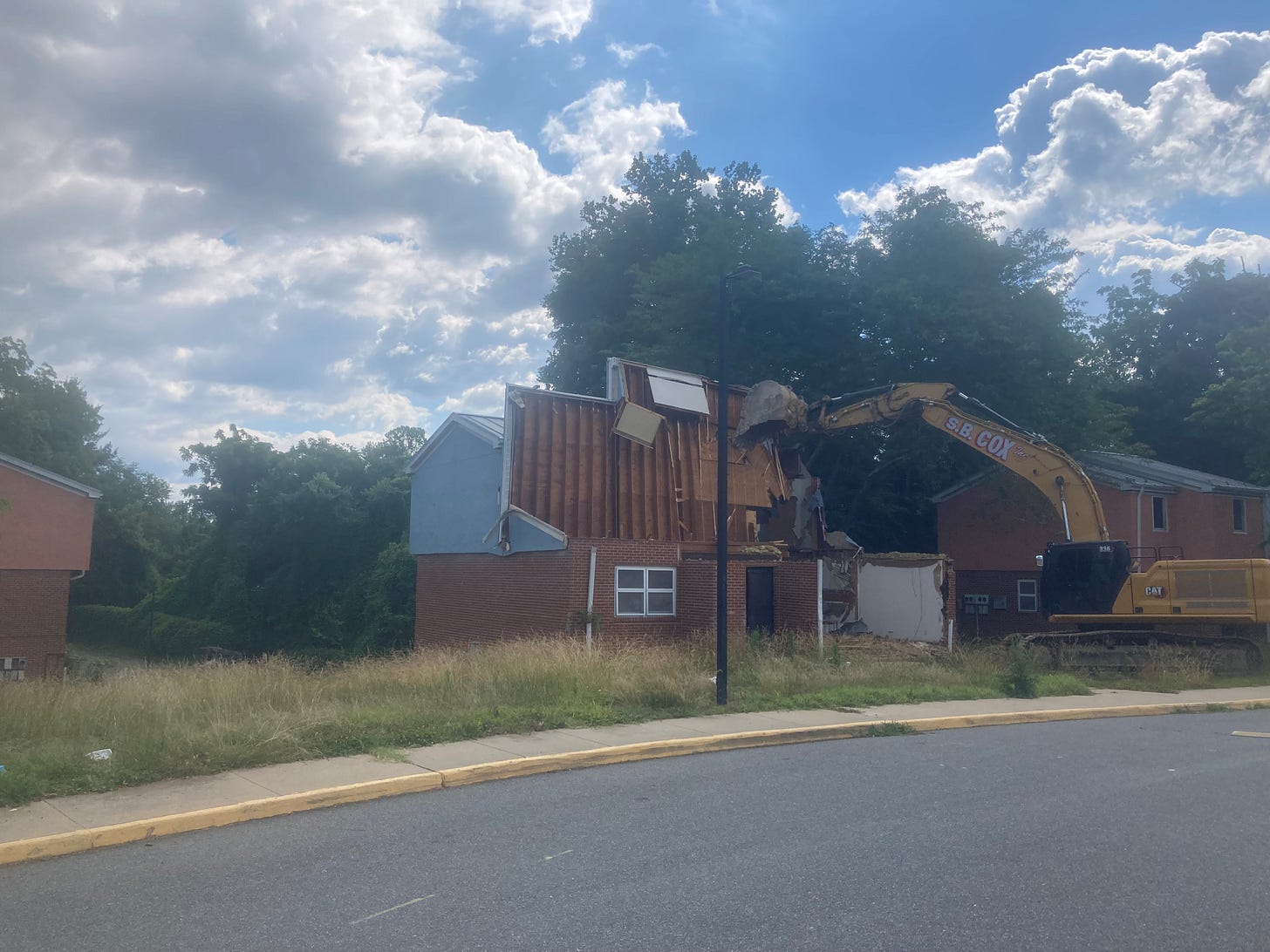
Reallocating Community Development Block Grants
Another theme this year has been the transfer of federal funds between projects. Since 1974, the U.S. Department of Housing and Urban Development has distributed Community Development Block Grants that can be used for a variety of different purposes.
Sometimes unspent money can be transferred to a different project, such as in March when City Council agreed to divert $215,000 to the Blue Ridge Food Bank for them to purchase a cold storage facility to expand the amount of produce they can keep on site for distribution.
That same day, a group of University of Virginia students commissioned by the Public Housing Association of Residents told Council that the funds should be used to support low-income residents with services and not used for physical infrastructure. They singled out the use of the funds for traffic calming on Ridge Street as well as its use to purchase smoke detectors, carbon monoxide detectors, and other fire safety devices.
Later in March, the New Hill Development Corporation got a transfer of $90,000 in CDBG funds to pay for unanticipated utility connections for their BEACON commercial kitchen on Carlton Avenue. That’s on top of $500,000 the agency received from the American Rescue Plan Act.
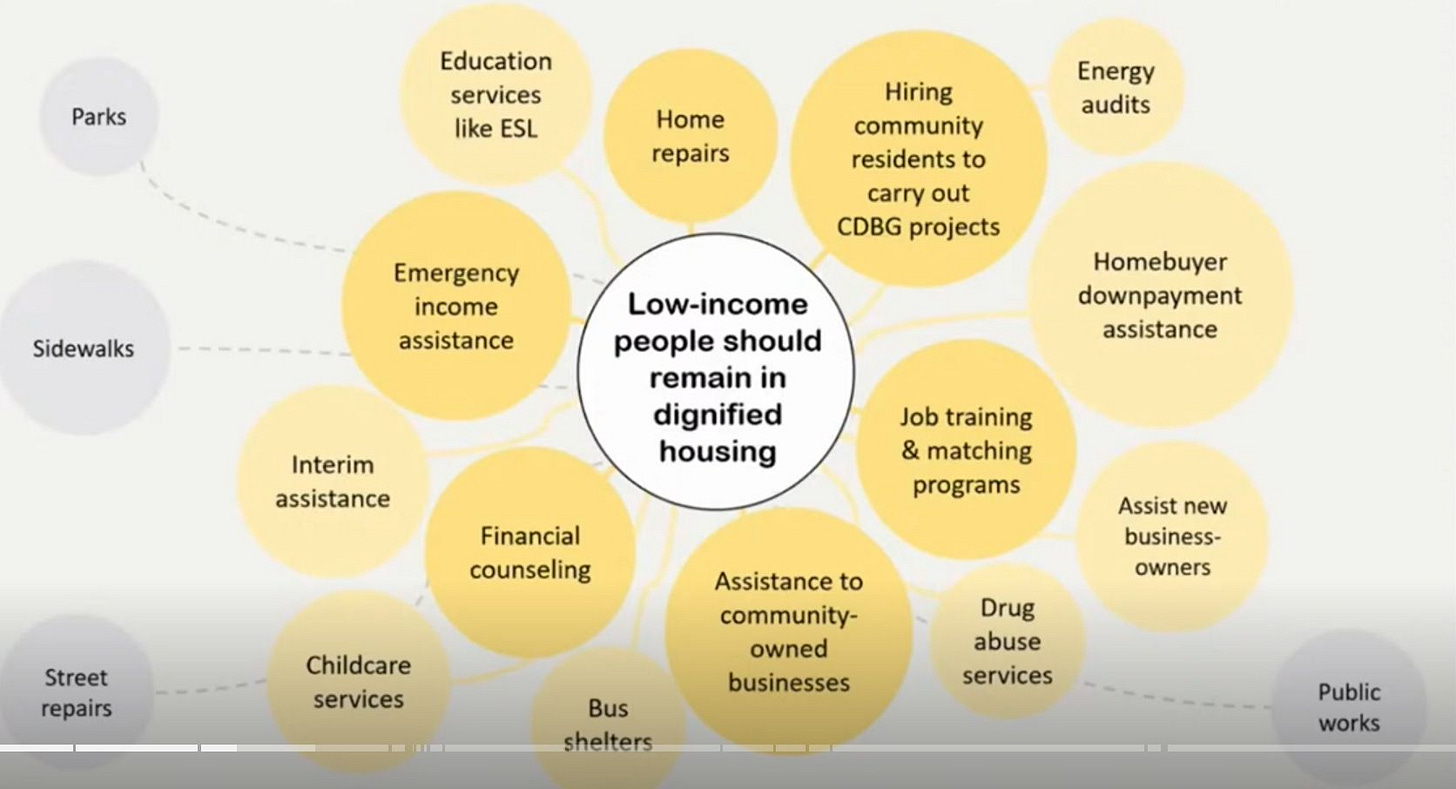
Yet Council continued to use CDBG funding to pay for infrastructure, such as a bicycle and pedestrian bridge in Jordan Park. They did so again in November for another bridge across Pollocks Branch CRHA’s new apartment complex on South First Street. (read that story)
Addressing the unhoused
Another major issue this year has been the ever-growing number of people without homes. There was a City Council work session in June that I confess I was not able to cover in detail but I previewed it. Conducting this year in review helps me remember what I didn’t get to but might want to look at still in the future. Maybe you do, too. So, here’s the link to the video.
The presentation is not yet within the meeting materials, but there’s still time to ask for it.
In September, City Manager Sam Sanders gave a preview of what would come up later in the fall.
“I have an internal working group, I’ve had external community conversations going on for the past few months,” Sanders said. “We are actively working with the Salvation Army and other partners hopefully to establish for the first time a permanent year-round low barrier shelter.”
A month later, Sanders provided more details at a work session with City Council. He told Council he wanted to use $1.5 million in American Rescue Plan Act funds to contribute to the Salvation Army’s initiative to expand its shelter on Ridge Street as well as additional funds to use the entity’s thrift store on Cherry Avenue for a low-barrier shelter.
“The goal has been to shutter the current Cherry Avenue thrift store and convert it to a low barrier shelter,” Sanders said. The question is how much is it going to cost and who’s going to run it? And those are the things that we’re still working on.”
This is a continuing story. Perhaps more will be in tomorrow’s Week Ahead?
More on the new Development Code
The City of Charlottesville spent nearly four years on a planning process that sought to create an affordable housing plan, a new Comprehensive Plan, and a new zoning code intended to create more places for people to live. The Cville Plans Together initiative kicked off in early 2020 just before the pandemic and culminated in late February when the new Development Code went into effect.
In January, a group of Charlottesville property owners in areas that had been upzoned filed a lawsuit seeking to throw out the new rules. They argued they would be harmed by the additional density and that the city has not sufficiently reviewed the impacts of a larger population on infrastructure such as transportation.
After being served in late February, the city responded by saying the plaintiffs wanted to deny housing opportunities to others and said they had followed the rules.
“The Plaintiffs already have that which they now seek to deny others—good, affordable housing in a desirable locality,” reads the introduction of the city’s demurrer in the case of White v. Charlottesville. “To do so, the Plaintiffs, having lost at City Council and at the ballot box, seek a judicial veto of the City’s zoning ordinance changes.” (read the demurrer)
Charlottesville Circuit Court Judge Claude Worrell presided over an hour and a half hearing in June before making a ruling in November that kept the possibility of a trial alive. He finally issued a written ruling in November that threw out two out of four counts but left two open.
“Plaintiffs have provided a sufficient question of fact for the Court to hear evidence regarding the promulgation of the new zoning ordinance,” said Charlottesville Circuit Court Judge Claude Worrell in a three-page ruling issued on November 12. (read the ruling)
Counsel for the plaintiffs filed an amended complaint this week.
Elsewhere in Virginia, a retired Fairfax Circuit Court Judge ruled against Arlington County’s “expanded housing options” provision which allowed a limited number of six-plex units to be constructed. That locality is appealing Judge Richard Schell’s September ruling. A written opinion was issued in late October.
This was also the year in which mandated public notices became part of my research routine. On February 1, City Council had two public hearings on a Thursday, something that had never happened in my time covering local government in the region. One was on the fee schedule for land use applications. The second removed an error in the Development Code that would have allowed for limited commercial uses in Residential-B and Residential-C zones.
Ever since I make sure I pick up every issue of the Charlottesville Daily Progress to see what I might have missed. More on public notices in the housekeeping section of this review.
Several projects continued to be reviewed under the old zoning, including a site plan for a replacement for Alumni Hall on Emmet Street. That also includes two student housing projects near the University of Virginia that opted to pay into the Charlottesville Affordable Housing Fund rather than provide income-restricted units.
The continuing role of the Board of Architectural Review
The new Development Code stripped out much of the role that City Council and the Planning Commission play in determining what gets built within city limits. In fact, the PC was not even asked to weigh in on the new Affordable Dwelling Unit Manual leaving that task to the Housing Advisory Committee. The PC meeting in March was the first after the Development Code was implemented and the agenda was mostly blank. In April, they did get an update on the implementation of the Development Code to date.
This year demonstrates the influence the Board of Architectural Review can play especially in the early days of figuring out the rules.
In late January, the BAR reviewed a preliminary design for a speculative purchase for two buildings in the 700 block of West Main Street, one of which formerly housed Mel’s Diner. In all there were three properties totaling just over 0.6 acres and all are in the Commercial Mixed Use 5 zoning district. Two of the properties are also in the West Main Architectural Control District which gives the BAR jurisdiction. The BAR gave preliminary feedback but no application ever materialized.
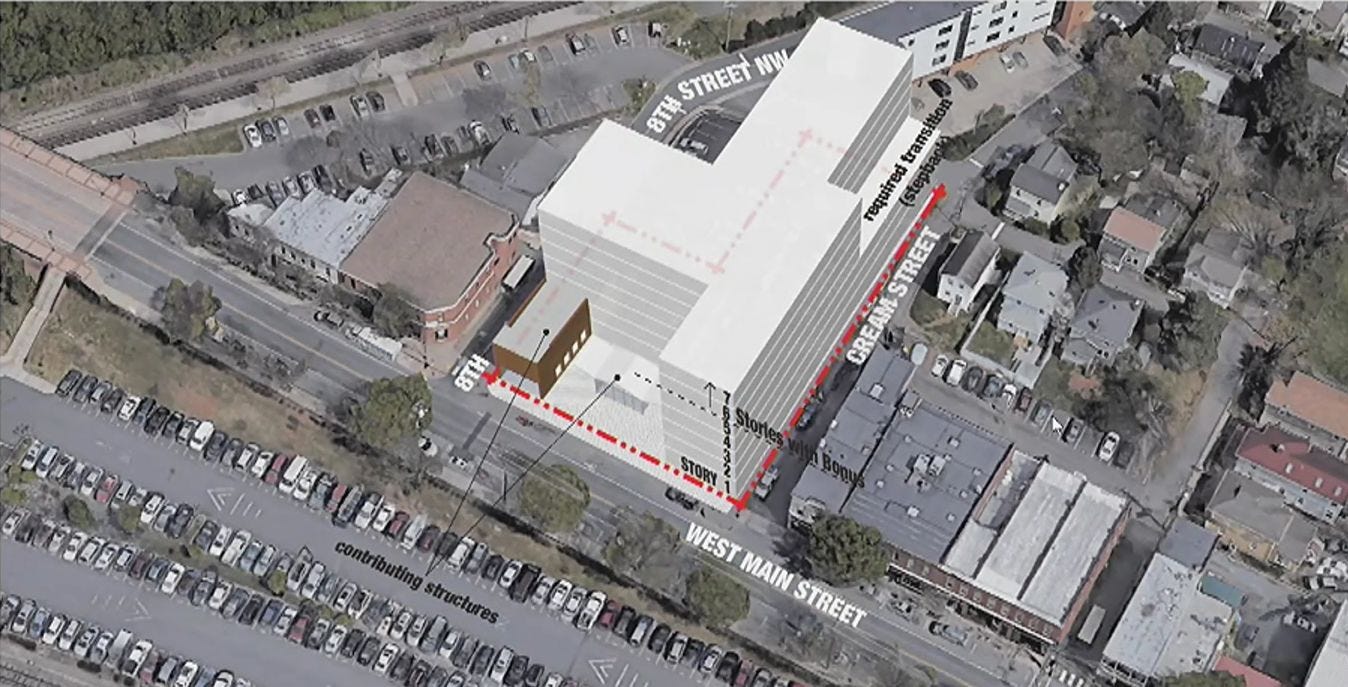
The BAR played a similar role in April when the principal of Heirloom Development asked for preliminary feedback on whether the body would support design changes at 218 West Market Street. Jeffrey Levien had previously obtained Council’s approval for a nine-story residential complex but sought a change.
“What we really want to understand today is whether the floor layouts with those rooms would work,” Levien said in April. “We are working with a brand so there are certain requirements you follow, certain layouts you follow.”
Levien would return to the BAR in November with a design, one that did not meet the favor of the appointed body.
The BAR also had two separate looks at a project at 10th and Wertland that the University of Virginia and its real estate foundation are donating land toward. The development team led by the nonprofit Preservation of Affordable Housing decided early in the process to construct a six-story building rather than go for the eleven stories they could get under the new Development Code.
“That makes life a little easier in regards to we’re not getting into a very, very tall building and getting into that discussion,” said Jeffrey Werner, the city’s historic preservation planner at a preliminary conversation in June.
In December, the BAR learned that the project is not being constructed at full height because steel construction would be too expensive for a structure intended to be financed through low-income housing tax credits.
What’s under review in the new Development Code
By the end of the year, several “major development plans” had begun to work their way through the city’s new process. One of them would see six townhouses built at 303 Alderman Road in the Lewis Mountain neighborhood. There are no affordable units required and none are proposed for this Residential B property. Approval has not yet been granted.
Another major development plan was filed for 2030 Barracks Road with the idea of building two dozen apartments. The by-right proposal would be to subdivide the property into two lots and to build 12 units on each. The land is within the Residential-B district which allows up to six units per lot but an additional six can be built if they meet the city’s affordability guidelines. Approval has not yet been granted and the city’s development portal does not include the document that states specifics on affordability.
Another major development plan was filed for 1609 Gordon Avenue where a five-unit apartment building would be replaced by a nine-unit apartment. Note that is one short of the threshold to provide one affordable unit per ten.
There’s also one for Hillcrest Road that would see 12 market-rate units built on three lots zoned as Residential-A. No affordable units are required.
No major development plan for residential units has been approved to date. Stay tuned to Charlottesville Community Engagement for arguably the most thorough coverage you’re going to get on this topic.




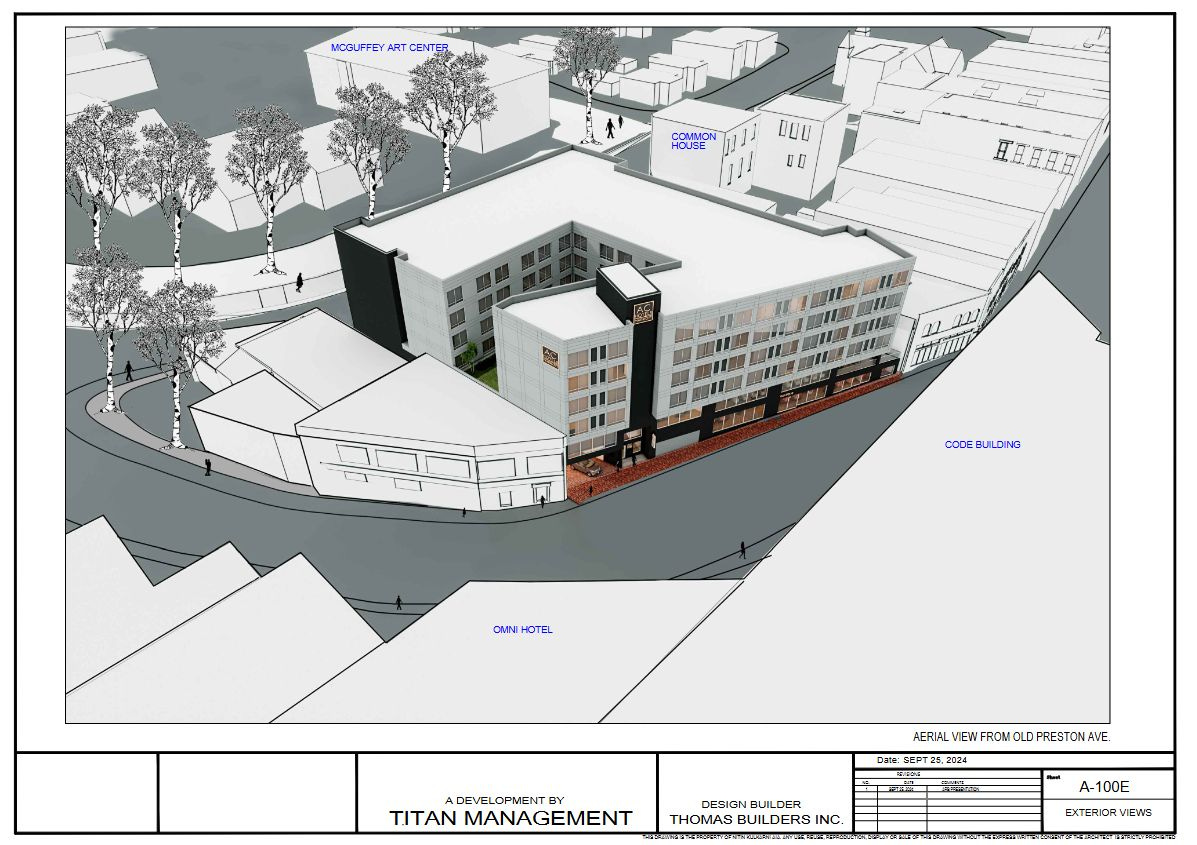
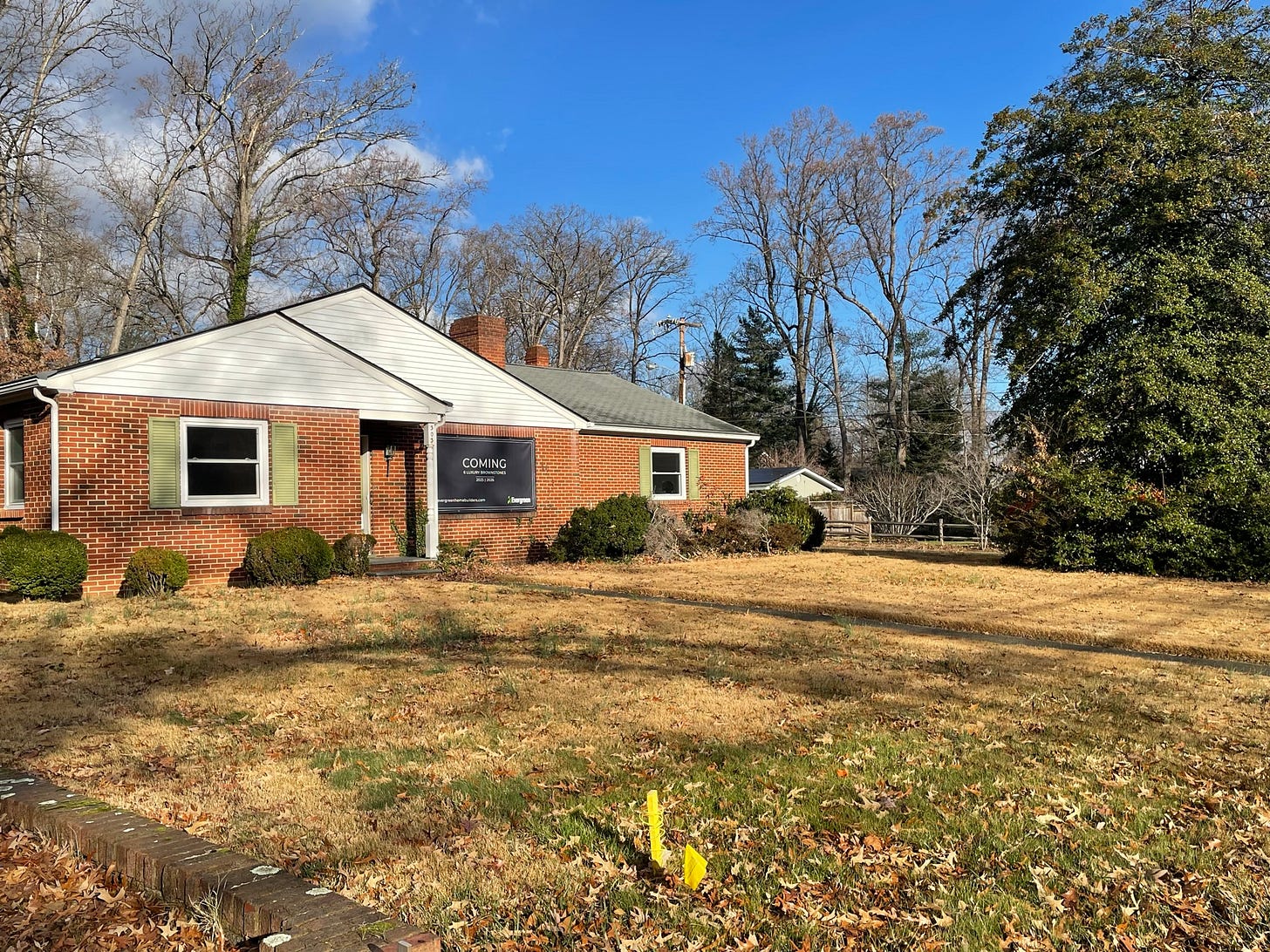

Well, as predicted, the new relaxed zoning code isn’t doing much for affordable housing yet, but it is spurring developers to hunt for tear downs .